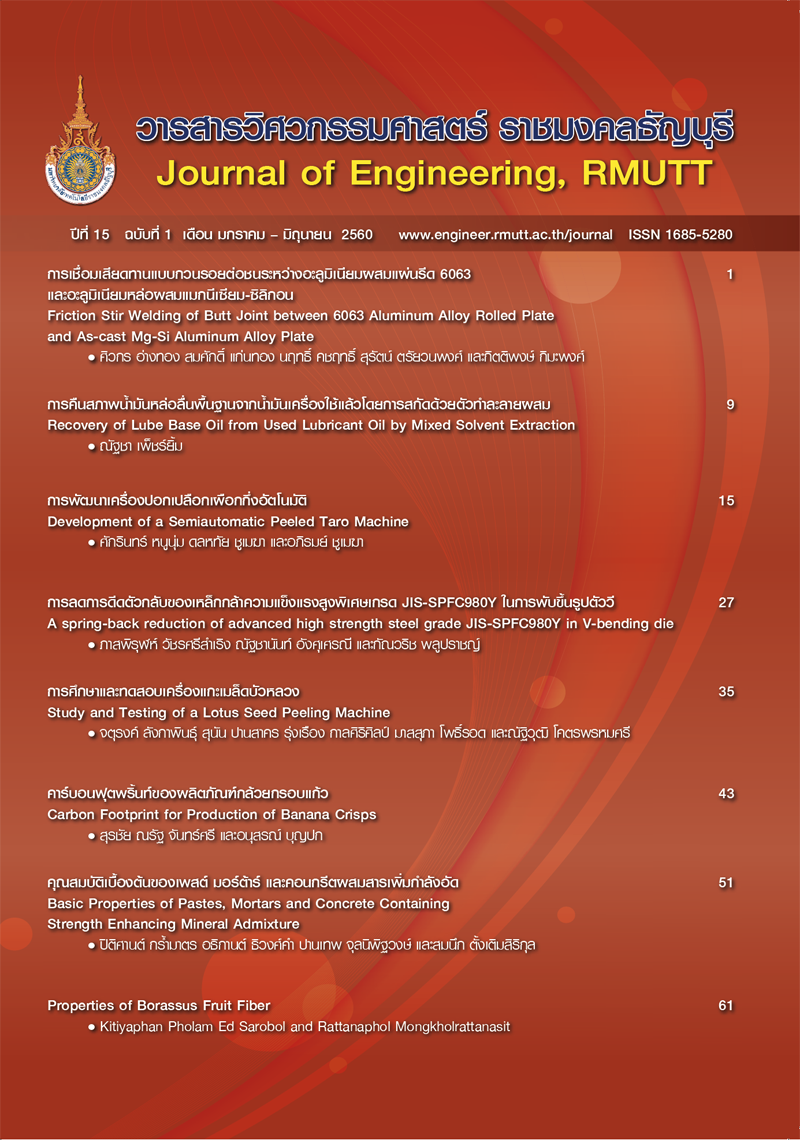Properties of Borassus Fruit Fiber
Main Article Content
Abstract
Borassus fruit fiber is a waste material from Borassus flour production, which is popular in Phetchaburi province, Thailand. Natural fiber developments for textile industry create value added benefits of agricultural waste material and increase farmers’ income. This paper focused on Borassus fruit fibers by studying their important properties such as physical, chemical, mechanical and structural aspects when they were scoured and bleached. They were determined according to ASTM standard and SEM, XRD and FTIR instruments were used. Highlight properties of fibers indicated that fibers consisted of three main components namely, α-cellulose, hemicellulose and lignin. When they were scoured and bleached, results showed that the percentage of α-cellulose was increased on scoured and bleached fibers but the percentage of hemicellulose and lignin was decreased. The crystallinity of untreated fiber was 67.16% and it was increased to 68.97% and 71.50% when the fibers were scoured and bleached respectively. Fiber diameter, length and linear density after scouring and bleaching were reduced. Tensile strength property was increased on scoured fiber but it was decreased on bleached fiber. For fiber surface morphology, we found that scoured and bleached fibers were cleaner than untreated fiber and numerous pores or pits were revealed on bleached fiber surface.
Article Details
The manuscript, information, content, picture and so forth which were published on Frontiers in engineering innovation research has been a copyright of this journal only. There is not allow anyone or any organize to duplicate all content or some document for unethical publication.
References
Farmthailand. 2013. The export of agricultural products of Thailand. AvailableSource: http://www.farmthailand.com/399, April 16, 2015.
Sirikasemlert, C. 2009. Eco textile, pp. 86-91 In Thailand Textile Institute., eds. Innovative Textiles. P2 design and print co., Ltd. Bangkok, Thailand.
Palmpedia. n.d. Borassus flabellifer. Available Source: http://www.palmpedia.net/wiki/Borassus_flabellifer, June 3, 2015.
Philippine medicinal plants. n.d. Palmira. AvailableSource: http://stuartxchange.com/Palmira.html, June 3, 2015.
Phetchaburi Provincial Agricultural Extension Office. 2016. Agricultural areas (2015). Available Source: www.phetchaburi.doae.go.th, May 3, 2016.
Mongkholrattanasit, R., J. Klayjoy, K. Arayaklua, K. Mahain, S. Jankeaw, S. Chonsakorn and N. Panrattanasin. 2014. Development of Borassus Fruit Fiber for Heat Insulation and Application for Technical Textile. Thailand Textile Institute.
Goering, HK and PJ. Van Soest. 1970. Forage fiber analyses (apparatus, reagent, procedures, and some applications). Agriculture Handbook No. 379, Agric Res Serv, USDA, Washington, DC, USA.
Van soest PJ, JB Robertson, and BA Lewis. 1991. Methods for dietary fiber, neutral detergent fiber, and nonstarch polysaccharides in relation to animal nutrition. J Dairy Zci 74: 3583-3597.
ASTM International. 2005a. ASTM D 5103 – 01 Standard test method for length and length Distribution of Manufactured Staple Fibers (Single-Fiber Test). ASTM Standards Book of Standard, vol. 07.01: D 76-D 4391.
ASTM International. 2005b. ASTM D1577-01 Standard test method for linear density of textile fiber. ASTM Standards Book of Standard, vol. 07.01: D 76-D 4391.
ASTM International. 2005c. ASTM D3822-01 Standard test method for tensile properties of single textile fiber. ASTM Standards Book of Standard, vol. 07.0: D 76-D 4391.
Susheel, K. and B.S. Kaith. 2009. Synthesis of flax-g-copolymers under pressure for use in phenolic composites as reinforcement. J. Chil. Chem. Soc., 54, No 2.
Obi Reddy, K., B. R. Guduri and A. Varada Rajulu. 2009. Structural Characterization and Tensile Properties of Borassus Fruit Fibers. Journal of Applied Polymer Science 114: 603–611.
Mathai, M P. 2005. Coir. Bast and other plant fibers. Woodhead Publishing Limited. Cambridge, England.
Chen, Y., J. Wan, Y. Ma, X. Dong, Y. Wang and M. Huang. 2015. Fiber properties of de-inked old newspaper plum after bleaching with hydrogen peroxide. Bioresources 10(1): 1857-1868.
Boopathi, L., P.S. Sampath and K. Mylsamy.
Investigation of Physical, Chemical and Mechanical Properties of Raw and Alkali Treated Borassus Fruit Fiber. Composites: Part B 43: 3044–3052.
Bachtiar, D., S. M. Sapuan and M. M. Hamdan. 2008. The effect of alkaline treatment on tensile properties of sugar palm fibre reinforced epoxy composites. Materials & Design, 29: 1285-1290.
Obi Reddy, M. Shukla, C.U. Maheswari and A. V. Rajulu. 2012. Mechanical and physical characterization of sodium hydroxide treated Borassus fruit fibers. Journal of Forestry Research 23(4): 667-674
Saravanan, D., N. Pallavi, R. Balaji and R. Parthiban. 2008. Investigations into structural aspects of Borassus flabellifer L (palmyrah palm) fruit fibres. Journal of the Textile Institute 99 (2): 133-140
Rayung, M., N. A. Ibrahim, N. Zainuddin, W. Z. Saad, N. I. A. Razak, and B. W. Chieng. 2014. The effect of fiber bleaching treatment on the properties of poly(lactic acid)/oil palm empty fruit bunch fiber composites. Int. J. Mol. Sci., 15: 14728-14742
Sgriccia, N., M.C. Hawley, and M. Misra. 2008. Characterization of natural fiber surface and natural fiber composites. Composites: Part A, 1632-1637
Moran, J.I., V.A. Alvarez, V.P. Cyras and A. Va´zquez. 2008. Extraction of cellulose and Preparation of nanocellulose from sisal fiber. Cellulose. 15: 149-159
Zhang, X., F. Wang and L. M. Keer. 2015. Influence of surface modification on the microstructure and thermos-mechanical properties of bamboo fiber. Materials, 8, 6597-6608.


